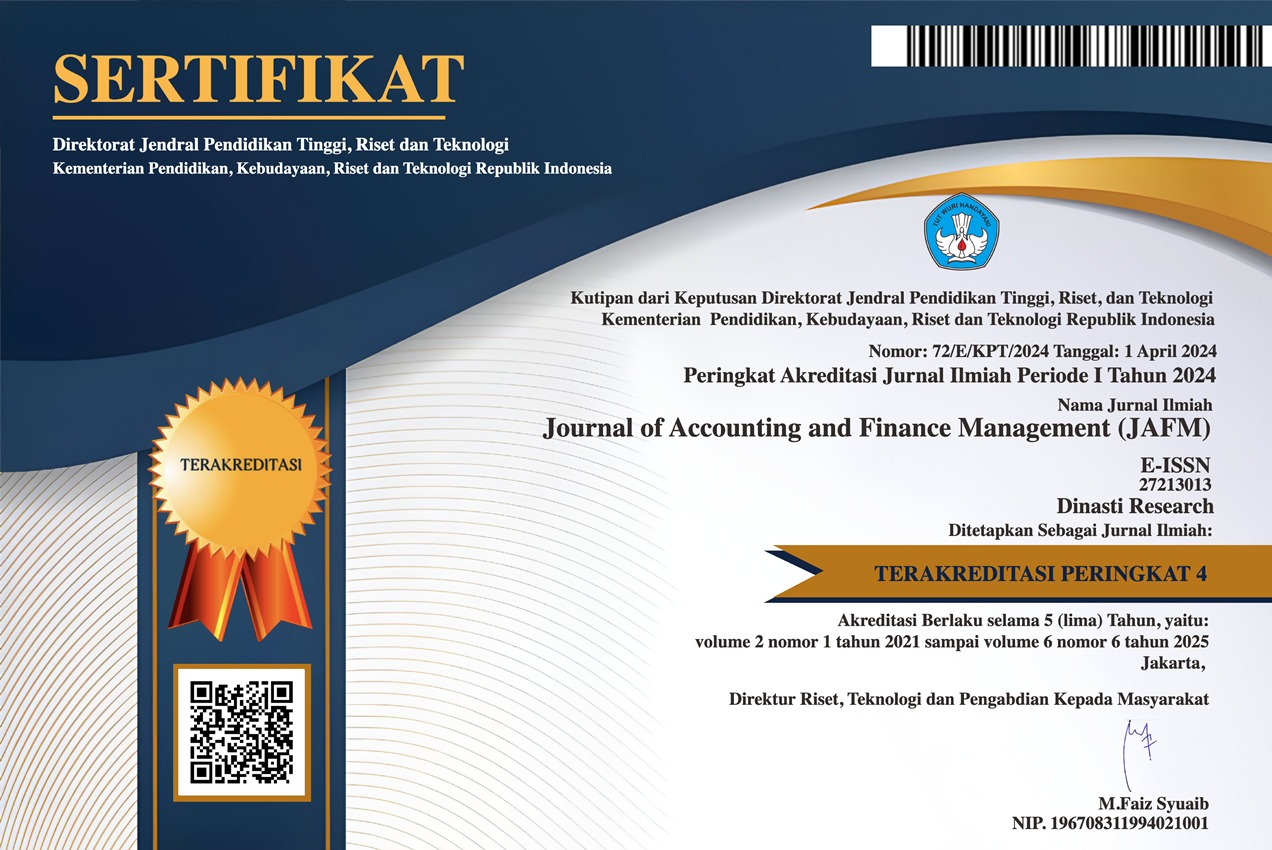The Effect of Toxic Workplace Environment and Job Burnout on Turnover Intention (Study: PT Steel Pipe Industry of Indonesia, Tbk – Unit V)
DOI:
https://doi.org/10.38035/jafm.v5i6.1351Keywords:
Toxic Workplace Environment, Job Burnout, Turnover IntentionAbstract
The main objective of this research is to explain the influence of a toxic workplace environment and job burnout on employee turnover intention at PT. Steel Pipe Industry of Indonesia, Tbk – Unit Karawang. Furthermore, this research aims to identify the influence of a toxic workplace environment and job burnout on employee turnover intention levels at PT. Steel Pipe Industry of Indonesia, Tbk – Unit Karawang. This research uses a quantitative approach and descriptive analysis, with a sample of 110 respondents. Data collection efforts in this research were carried out using a survey method in the form of a questionnaire. The results of multiple linear regression equation modeling were obtained using SPSS for Windows software. The research results show that toxic workplace environment and job burnout have a positive effect on turnover intention. The findings in this research will help company management, policy makers and practitioners to formulate policies to reduce toxic workplace environments, job burnout and turnover intention among company employees.
References
Abate, J., Schaefer, T., & Pavone, T. (2018). Understanding generational identity, job burnout, job satisfaction, job tenure and turnover intention. Journal of Organizational Culture, Communications and Conflict, 22(1), 1-12. In Journal of Organizational Culture, Communications and Conflict (Vol. 22, Issue 1).
Acquadro Maran, D., Varetto, A., Zedda, M., & Magnavita, N. (2018). Workplace Violence Toward Hospital Staff and Volunteers: A Survey of an Italian Sample. Journal of Aggression, Maltreatment and Trauma. https://doi.org/10.1080/10926771.2017.1405314
AK, B. (2018). Turnover Intention Influencing Factors of Employees: An Empirical Work Review. Journal of Entrepreneurship & Organization Management. https://doi.org/10.4172/2169-026x.1000253
Cheung, T., & Yip, P. S. F. (2015). Depression, anxiety and symptoms of stress among Hong Kong nurses: A cross-sectional study. International Journal of Environmental Research and Public Health. https://doi.org/10.3390/ijerph120911072
Dewi, C. N. C., Bagia, I. W., & Susila, G. P. A. J. (2014). Dewi dkk 2014. E-Journal Bisma Universitas Pendidikan Ganesha, 2.
Djafar, A., & Alauddin Makassar, U. (2020). Pengaruh Stres Kerja, Promosi Jabatan dan Komitmen Organisasi Terhadap Turnover Intention Karyawan Pada PT. Maruki International Indonesia. Study of Scientific and Behavioral Management (SSBM).
Dubas, K. M., & Nijhawan, I. P. (2007). A hman capital theory perspective of sales force training, productivity, compensation, and turnover. Proceeding of the Academy of Marketing Studies.
Excerpted, Maslach, C., Schaufeli, W. B., & Leiter, M. P. (2001). What is Job Burnout. Annual Review of Psychology.
Hashim, A., Azman, N. S., Ghani, M. A., & Mohamad Sabri, M. F. (2016). the Relationship Between Work-Life Balance and Employee Retention. D International Conference on Management & Muamalah.
Infante, A., & Darmawan, D. (2022). Gender Equality: Women’s Involvement in Human Resource Management Practices. Journal of Social Science Studies (JOS3). https://doi.org/10.56348/jos3.v2i1.16
Ksama, I. B. P. T., & Wibawa, I. M. A. (2016). Pengaruh Leader-Member Exchange, Role Stress Dan Perceived Organizational Support Terhadap Turnover Intention. E-Jurnal Manajemen Universitas Udayana.
Low, *, Beng, S., & Mahadevan, A. (2023). Impact of Toxic Work Environment on Employee Turnover Intention in Pharmaceutical Industry, Klang Valley, malaysia. International Journal of Recent Advances in Multidisciplinary Research, 10(08), 8709–8715. www.ijramr.com
Lutgen-Sandvik, P., & Alberts, J. K. (2006). Nightmares, Demons, and Slaves: Exploring the Painful Metaphors of Workplace Bullying. Management Communication Quarterly. https://doi.org/10.1177/0893318906291980
Maslach, C., Jackson, S., & Schwab, R. (1996). Maslach burnout inventory-educators survey (MBI-ES). In MBI Manual, 3rd ed.
Maslach, C., & Leiter, M. P. (2016). Understanding the burnout experience: Recent research and its implications for psychiatry. World Psychiatry. https://doi.org/10.1002/wps.20311
Moslem, M., & Sary, F. P. (2021). Pengaruh Ketidakamanan Kerja dan Stres Kerja Terhadap Intensi Turnover Pada Karyawan Kaltim Post Samarinda. Psikostudia?: Jurnal Psikologi. https://doi.org/10.30872/psikostudia.v10i2.5221
Pouliakas, K., & Theodossiou, I. (2013). the economics of health and safety at work: An interdiciplinary review of the theory and policy. Journal of Economic Surveys. https://doi.org/10.1111/j.1467-6419.2011.00699.x
Rahim, A., & Cosby, D. M. (2016). A model of workplace incivility, job burnout, turnover intentions, and job performance. Journal of Management Development. https://doi.org/10.1108/JMD-09-2015-0138
Rahman Bin, M. M. A., Samsudin, Radzuan Noor, R. A., Nazarudin, D., Gopala Krishnan Sekharan, N., & Ayob. (2012). The Study of Teamwork and its Effects towards Loyalty in Hotel Industry in Klang Valley, Malaysia. In International Journal of Academic Research in Progressive Education and Development.
Rasool, S. F., Wang, M., Tang, M., Saeed, A., & Iqbal, J. (2021). How toxic workplace environment effects the employee engagement: The mediating role of organizational support and employee wellbeing. International Journal of Environmental Research and Public Health. https://doi.org/10.3390/ijerph18052294
Rowe, M. M., & Sherlock, H. (2005). Stress and verbal abuse in nursing: Do burned out nurses eat their young? In Journal of Nursing Management. https://doi.org/10.1111/j.1365-2834.2004.00533.x
Slavianska, V. (2012). Measuring the Impact of Human Resource Management Practices on Employee Turnover. Problems of Management in the 21st Century, 4(1), 63–73. https://doi.org/10.33225/pmc/12.04.63
Downloads
Published
How to Cite
Issue
Section
License
Copyright (c) 2025 Hesty Monica, Neuneung Ratna Hayati

This work is licensed under a Creative Commons Attribution 4.0 International License.
Authors who publish their manuscripts in this journal agree to the following conditions:
- The copyright on each article belongs to the author(s).
- The author acknowledges that the Journal of Accounting and Finance Management (JAFM) has the right to be the first to publish with a Creative Commons Attribution 4.0 International license (Attribution 4.0 International (CC BY 4.0).
- Authors can submit articles separately, arrange for the non-exclusive distribution of manuscripts that have been published in this journal into other versions (e.g., sent to the author's institutional repository, publication into books, etc.), by acknowledging that the manuscript has been published for the first time in the Journal of Accounting and Finance Management (JAFM).
























